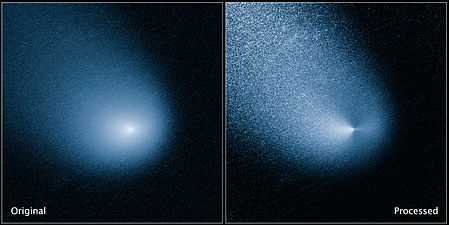(163132) 2002 CU11
| Discovery[1] | |
|---|---|
| Discovered by | LINEAR (704) |
| Discovery date | 07 February 2002 |
| Designations | |
| MPC designation | (163132) 2002 CU11 |
|
Apollo NEO, PHA[2] | |
| Orbital characteristics[2] | |
|
Epoch 2013-Nov-04 (Uncertainty=0)[2] | |
| Aphelion | 1.581 AU (Q) |
| Perihelion | 0.8597 AU (q) |
| 1.220 AU (a) | |
| Eccentricity | 0.2954 |
| 1.35 yr | |
| 182.3° (M) | |
| Inclination | 48.77° |
| 157.8° | |
| 110.6° | |
| Physical characteristics | |
| Dimensions | ~730 meters (2,400 ft)[3] |
| Mass | 5.3×1011 kg (assumed) |
| 18.3[2] | |
|
| |
(163132) 2002 CU11, provisionally known as 2002 CU11, is a near-Earth asteroid and potentially hazardous object.[2] It was discovered on 7 February 2002 by Lincoln Near-Earth Asteroid Research (LINEAR) at an apparent magnitude of 19 using a 1.0-meter (39 in) reflecting telescope.[1] It has an estimated diameter of 730 meters (2,400 ft).[3] The asteroid was listed on Sentry Risk Table with a Torino Scale rating of 1 on 20 March 2002.[3]
With an observation arc of 44 days, 2002 CU11 showed a 1 in 9,300 chance of impacting Earth in 2049.[4] It was removed from the Sentry Risk Table on 26 April 2002.[5] It is now known that on 3 September 2049 the asteroid will be 0.0843 AU (12,610,000 km; 7,840,000 mi) from Earth.[6]
| Date | Distance from Earth |
|---|---|
| 1925-08-30 | 0.0023 AU (340,000 km; 210,000 mi) |
| 2014-08-30 | 0.0346 AU (5,180,000 km; 3,220,000 mi) |
| 2049-09-03 | 0.0843 AU (12,610,000 km; 7,840,000 mi) |
| 2080-08-31 | 0.0042 AU (630,000 km; 390,000 mi) |
References
- ↑ 1.0 1.1 "MPEC 2002-C44 : 2002 CU11". IAU Minor Planet Center. 2002-02-08. Retrieved 2013-09-18. (K02C11U)
- ↑ 2.0 2.1 2.2 2.3 2.4 "JPL Small-Body Database Browser: 163132 (2002 CU11)" (2010-08-11 last obs and observation arc=8.5 years). Jet Propulsion Laboratory. Retrieved 2013-09-18.
- ↑ 3.0 3.1 3.2 "Current Impact Risks (2002 CU11)". Near-Earth Object Program. NASA. 2002-03-21.
- ↑ Andrea Milani, Giovanni Valsecchi and Maria Eugenia Sansaturio (2002). "The problem with 2002 CU11". Spaceguard / Tumbling Stone. Retrieved 2013-09-18.
- ↑ "Date/Time Removed". NASA/JPL Near-Earth Object Program Office. Retrieved 2013-09-18.
- ↑ 6.0 6.1 "JPL Close-Approach Data: 163132 (2002 CU11)" (2010-08-11 last obs and observation arc=8.5 years). Retrieved 2013-09-18.
External links
- Orbital simulation from JPL (Java) / Ephemeris
| Preceded by (152680) 1998 KJ9 |
Large NEO Earth close approach (inside the orbit of the moon) 30 August 1925 |
Succeeded by 2002 JE9 |
| |||||||||||||||||||||||||||||||||||||||||


